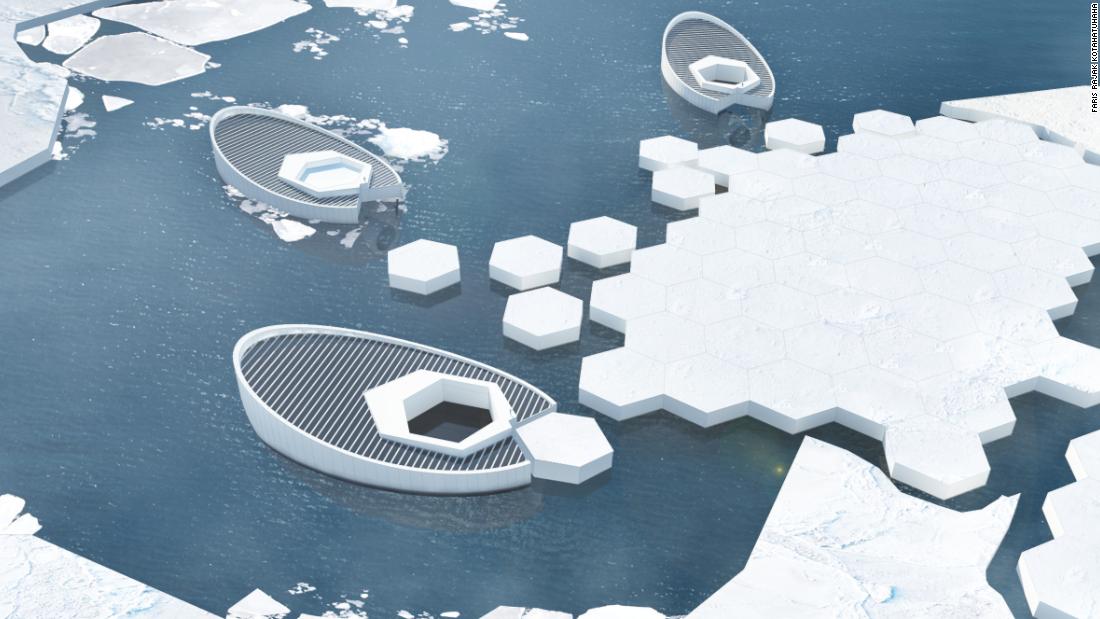[ad_1]
That’s a question posed by a team of Indonesian designers with an eye-catching response to the climate crisis: iceberg-making submarines.
Led by 29-year-old architect Faris Rajak Kotahatuhaha, the group envisaged a submersible vessel capable of producing 16-foot-thick, 82-foot wide hexagonal icebergs.
The process would begin with the submarine dipping beneath the surface to fill its central cavity with seawater. Salt would then be filtered out, raising water’s freezing point by more than 3 degrees Fahrenheit, after which a hatch closes over the chamber to protect it from the sun.

The proposed vessel would be large enough to host research and leusire facilities. Credit: Faris Rajak Kotahatuhaha
An iceberg would then form naturally inside, before being ejected a month later. According to the team behind the project, the hexagonal shape may encourage the icebergs (or “ice babies” as Kotahatuhaha refers to them) to interlock with one another and form larger frozen masses.
It’s an early concept design, and many questions remain. The designers are yet to finalize how the vehicle would be powered, though they intend for the vessel to be fully sustainable. But could the submarines, in theory, work?
Andrew Shepherd, a professor of Earth observation at the UK’s Leeds University, described the idea as an “interesting engineering solution,” though he questioned the project’s scalability. He estimated that replacing polar ice at the same rate it has disappeared in the last four decades would require around 10 million submarines.
“That’s a lot of machines,” Shepherd said in an email. “For context, that’s not far off the total number of Model-T Fords built in all time.”

The proposed submersible would be capable of producing 16-foot-thick, 82-foot wide hexagonal icebergs. Credit: Faris Rajak Kotahatuhaha
But for Kotahatuhaha, the proposal is not only about feasibility — it’s about finding a different way to approach climate challenges.
“The Arctic has lost ice from year to year in the last decade,” he said on the phone from Jakarta. “So we tried to solve the problem through a different way of thinking.
“Richer countries have millions to spend on (sea walls and) protection, but what about poor countries with no budget for (defending against) rising sea levels? This is a problem the world now faces together. We have a different approach: Rather than defending against sea level rises, we think it’s better (to carry out) some kind of intervention to tackle the problem.”
Protecting the poles
A possible flaw in the proposal — and others like it — is that making ice does not significantly alter sea levels. If the ice is still floating in the water it formed from, then sea’s overall mass doesn’t change. (The icebergs would have to be “moved on to land” if they were to lower sea levels, Shepherd said).
But reversing, or at least slowing, the alarming decline of polar sea ice is about more than rising oceans. Snow and ice reflect significantly more sunlight than open water does, so bigger, frozen surfaces mean more radiation is sent back to space.
“If enough (ice) is made, then it could ultimately alter the planet’s temperature, which could in turn lead to reduced land ice melting and reduced sea level rise from that source,” Shepherd said, offering an alternative advantage to making icebergs. “But there are lots of ‘ifs’ along the way.”
Related video: Artificial gills for humans could become a reality
The scientists’ research suggested that using 10 million of the devices could add a meter (3.2 feet) onto the surface of a polar ice sheet over the course of a winter.
Other proposals have focused on protecting ice rather than creating it.
Since 1990, British physicist John Lanham has explored a technique known as marine cloud brightening, in which particles — such as the salt in seawater — are injected into clouds to increase the amount of sunlight they reflect. Together with Stephen Salter, a professor of engineering design at the University of Edinburgh, Lanham developed a concept design for a floating “spray vessel” which could fire seawater into the clouds via a series of masts.
Brighter clouds could mean that less sunlight reaching the Earth’s surface, thus reducing summer melting and encouraging the replenishment of ice during the winter.

Non-profit group Ice911 has developed a highly reflective sand-like material that can be scattered on ice to reflect more of the sun’s rays back to space. Credit: Ice911/Alexander Sholtz
Detractors say that plans to refreeze the Arctic address the symptom, not the cause. Indeed, even if proposals did prove feasible, none would combat the carbon consumption responsible for diminishing sea ice in the first place.
But for Kotahatuhaha and his team, big problems require bold innovation. While he accepts that his iceberg-making submarines are a “utopian project,” he wants experts from different fields to help build radical visions into viable solutions.
“Architects cannot build skyscrapers alone,” he offered as an analogy. “(They) need collaboration from civil engineers, electrical engineers, economists and others.
“If there are too many limitations, there will be no innovation,” he added. “Innovation is the first step to opening (our) way of thinking, then technology and research regarding … feasibility must be deepened.”
[ad_2]
Source link

